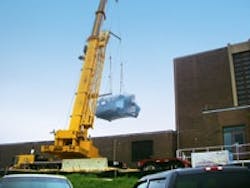About the author: Christopher Komline is vice president of Komline-Sanderson. Komline can be reached at [email protected] or 908.234.1000.
The Upper Blackstone Water Pollution Abatement District’s (UBWPAD) wastewater treatment plant serves seven communities in the Worcester, Mass., area and portions of four others, and is located in nearby Millbury. It is the largest wastewater treatment plant discharging into the 46-mile-long Blackstone River, which is known as the “Birthplace of the American Industrial Revolution.” Along its 46-mile journey, the river descends 438 ft, making it a steeper gradient than the Colorado River. This created the perfect conditions for Samuel Slater to build his textile mill in 1793, and at one point in its history, the river had almost one dam for every mile along its course and still has 16 today.
Stringent Treatment Requirements
UBWPAD is permitted for a flow of 56 million gal per day (mgd) and in 2012 had an average flow of 26.1 mgd with peak flows of 160 mgd. In addition to the indigenous sludge from its member communities, a small amount of imported wastewater and septage is delivered. As treatment requirements have become more stringent over the past decade, more processes and equipment have been added, and the costs have increased accordingly. Since 2003, the cost to the user has increased from just under $2 to $5.50 to treat 100 cu ft of flow.
UBWPAD uses a waste-activated sludge process with primary clarifiers, biological nutrient removal in the secondary treatment section, dissolved air flotation thickening, and belt press dewatering followed by incineration. The residual ash is landfilled at the treatment plant site. The final effluent is treated with sodium hypochlorite and sodium bisulfite prior to discharge into the Blackstone River. Plant water (final effluent) prior to sodium bisulfite dosing has various uses throughout the process, including belt press wash water and off-gas treatment for the incinerator.
Plant personnel have spent many years perfecting the plant by pilot testing equipment prior to purchase. According to Mark Johnson, deputy director, “piloting has worked well for us because the manufacturers get to see the nature of the plant and the occasional difficulties and intricacies of the different processes.” And staff know the equipment will do the job properly once it has passed the pilot test.
Since 1973, Komline-Sanderson has supplied nine Kompress belt filter presses and more than 20 plunger pumps for the UBWPAD plant in Millbury.
In 1982, district purchased its first Kompress for sludge dewatering. The second was purchased in 1985, the third in 1990, the fourth in 1993 and the fifth in 1997. In 2011, UBWPAD purchased four G-GRSLX-2 belt filter presses to replace the existing units, which at that point were between 14 and 21 years old. These 2-meter-wide belt presses handle 194 gal per minute (gpm) of the blended primary and thickened secondary sludge at 4% solids, yielding a 25% dry solids cake. Cake pumps then send the resulting 49 gpm of dewatered cake to the multiple-hearth incinerators. The secondary-to-primary ratio is approximately 2.5 to 1. UBWPAD is permitted to operate its two incinerators at 72 dry tons per day, but currently runs one continuously at 17.3 dry tons per day. This works out to 0.66 dry tons per mgd.
Moving Sludge
UBWPAD uses Komline-Sanderson plunger pumps to move various sludges throughout its plant in Millbury. Applications such as primary sludge transfer and thickened dissolved air flotation sludge drains are routinely and reliably handled by plunger pumps. Some of the pumps have been in service for 40 years. In fact, most of the first six pumps purchased in 1973 are still pumping. It helps that Bob Maynard and his maintenance team keep the entire plant running effectively. Primary sludge is transported through plunger pumps to the sludge blending tank. Another set of plunger pumps then transfer the blended sludge to the sludge mix tanks in the dewatering building prior to dewatering on the belt filter presses. Most of the plunger pumps are activated automatically by instrumentation to maintain specific tank levels throughout the facility and keep everything in balance.
The Komline-Sanderson simplex Model KSS-9-1 handles scum at flow rates up to 80 gpm while the Model KSS-11-3 transfers sludge at rates up to 320 gpm at heads up to 140 ft total dynamic head. All of the units are self-priming and designed for 10-ft suction lifts, which allows flexibility for the plant in its processes. UBWPAD appreciates the pumps because they have low operating costs and are easy to maintain.
For 40 years, UBWPAD and Komline-Sanderson have worked together to ensure a smooth-running wastewater treatment plant on an historic and important river.
Download: Here
